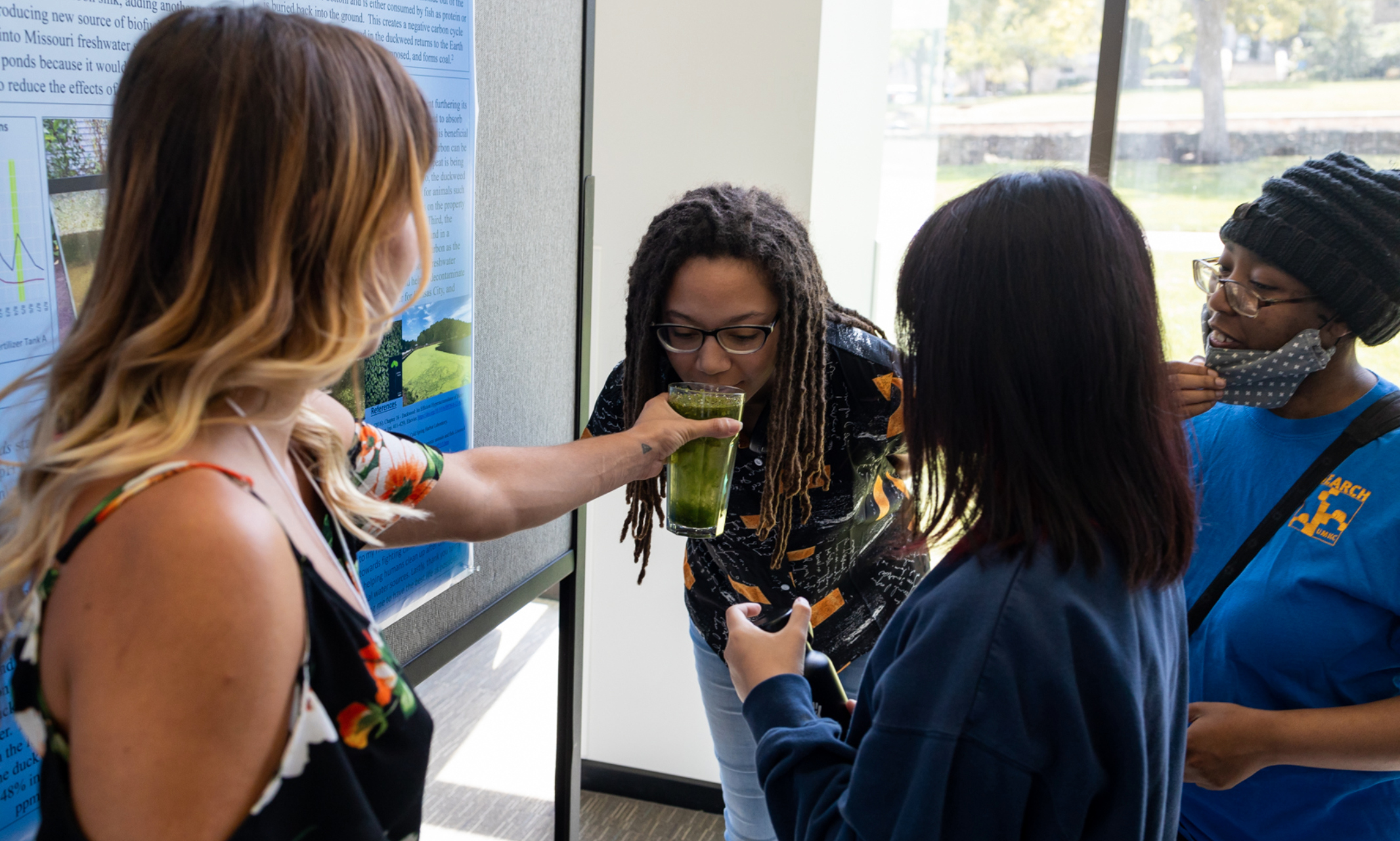Amanda Pierce had already launched her professional career at EcoSafe Environmental Services in the Crossroads District after finishing her degree requirements at the end of July. So, what was she doing back on campus in August, standing in front of a poster in Miller Nichols Library and Learning Center?
Living her passion.
The poster described her research into duckweed, an innocuous-looking but environmentally powerful plant. She earned her final credits for her degree in earth and environmental science researching the ability of duckweed to do double duty sequestering carbon dioxide while removing contaminants in waterways. She had the credits, the degree and the professional career, but she came back to present and discuss her findings at the annual UMKC SUROP Poster Symposium.
“I’m very passionate about my research,” she explained. “At first, I wasn’t really even doing (the research) for school. I put my time and energy into it, and I was proud of it, and I wanted to share this cool information with people.”
That’s the secret of SUROP (Summer Undergraduate Research Opportunity), one of several UMKC programs that encourage undergrads to dive deep into their studies by funding research expenses for approved projects. The programs create a bridge linking passion to tangible performance.
SUROP grants provide students with a $2,000 tuition grant and up to $1,250 in reimbursable research expenses for projects undertaken during the summer. The SUROP Poster Symposium celebrates the work that undergraduate researchers, scholars and artists and their faculty mentors have accomplished during the summer months.
Information about undergraduate research opportunities, funding and application deadlines is available at the Undergraduate Research and Creative Scholarship page.
Pierce was one of 19 students who received funding for summer research projects this year, on topics ranging from the urban heat island effect in Kansas City, to health policies related to child obesity, to using 3-D printing to create structures that mimic living tissue.
Another was Laura Munoz-Baroja, who also competes as a scholarship athlete on the UMKC women’s tennis team. She tested techniques for improving the efficiency and performance of solar energy panels.
Current panels convert only about 20 percent of the solar radiation they receive into electricity, and the rest gets converted into heat, which limits the performance of the panel. Munoz-Baroja investigated coatings that can convert more of the light entering the panel into wavelengths that produce electricity instead of heat. By using external coatings, the enhancement can be applied to existing panels without expensive and time-consuming internal design changes. She tested coating materials that are durable enough to last as long as the panels, even under exposed outdoor conditions.
Sam Sisk also focused his research on keeping things cool, but his medium was semiconductor computer chips. At temperatures above 80 degrees C., the speed and accuracy of chips declines significantly, so cooling has always been a key element of the design of computerized equipment. Cooling systems integrated into chips is the modern solution, but those systems create less than ideal interaction between the chip and the coolant. Sam’s solution: go small. He designed a miniaturized system for injecting liquid coolant directly onto the surface of individual chips, generating more direct contact with the coolant while requiring minimal energy to pump the liquid.
2022 SUROP Presenters
Shuyuan Tian, Chemistry
Chirality-Driven Self-Assembly: In Situ Preparation of Structurally Distinct Janus
Dendrimers
Faculty Mentor: Shin Moteki
Kate Larberg, Earth and Environmental Science
Making the Kansas City Urban Heat Island Effect Approachable
Faculty Mentor: Fengpeng Sun
Kaitie Butler, Mechanical Engineering, Honors Program
Fabrication of Color-Changing Materials Using Liquid-in-Liquid 3D Printing Methods
Faculty Mentor: Zahra Niroobakhsh
Laura Munoz-Baroja, Energy, Matter and Systems
Performance Enhancement of PV/T Systems Integrated with Nanofluids
Faculty Mentor: Sarvenaz Sobhansarbandi
Christian Dang, Biology, Honors Program
A Self-Directed Mutagenesis Approach for Examining the Drosophila Tribbles
Recognition Degron in the C/EBP Transcription Factor Slbo
Faculty Mentor: Leonard Dobens
Jay Vanderslice, Physics
Creating Continuous and Universal Paths for Crystal Structures
Faculty Mentor: Paul Rulis
Charlotte Rooney, Earth and Environmental Science
Assessment of Urban Prairie and Phytoremediation Plants as a Means to Regenerate
Urban Soil
Faculty Mentor: Caroline Davies
Amanda Pierce, Earth and Environmental Science
Decontamination and Carbon Sequestration of Missouri Freshwater by Duckweed
Faculty Mentor: Alison Graettinger
MaAh Kyi, English/History
The Missouri Bicentennial Project: Recent Immigration
Faculty Mentor: Diane Mutti Burke
Judy Vun, Nursing
A Secondary Data Analysis of the Child Obesity and Health Messaging Preferences
among Missouri Policymakers (CHAMP) Study
Faculty Mentor: Anita Skarbe
Sam Sisk, Mechanical Engineering
In-Chip Cooling Technology within Semiconductor Switches
Faculty Mentor: Sarvenaz Sobhansarbandi
Saivagmita Kantheti, Six-Year BA/MD
A Text Mining Approach to Determine Correlations between the Spanish Flu and
COVID-19
Faculty Mentor: Billie Anderson, Ph.D.
Britton Needham, Biology/Chemistry
Probing Biological Redox Chemistry with Microelectrodes
Faculty Mentor: Mohammad Rafiee
Drew Nelson, Mechanical Engineering
Small Rifle Primer Characterization
Faculty Mentor: Travis Fields
India Fernandez, Biology
Creation and Repair of Educational Anatomy Models
Mentor: Rachael Allen
Michael Englert, Mechanical Engineering
Development of a Highly Thermal Conductive Nanofluid for the Application in Solar
Thermal Technologies
Faculty Mentor: Sarvenaz Sobhansarbandi
Hannah Briggs, Biology
Chirality-Driven Self-Assembly: Application toward Renewable/Exchangeable
Resin-Immobilized Catalysts
Faculty Mentor: Shin Moteki
Luke Romang, Earth and Environmental Science
Depositional Setting, Provenance, and Tectonic Implications of the Carmen Formation
on San Marcos Island, Baja California Sur, México
Faculty Mentor: Tina Niemi
Austin Cass, Mechanical Engineering, Honors Program
Creating Soft, Gel-Like Tubes for Biomimicking Tubular Tissues Using Liquid-in-Liquid
3D Printing
Faculty Mentor: Zahra Niroobakhsh

